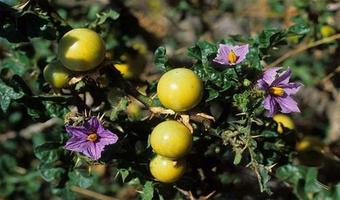 Farmers who have struggled with the poisonous and invasive Sodom Apple responsible for deaths of their livestock can now breathe easy after it was established that the wild animals’ appetite for the plant is helping tame its spread.
Farmers who have struggled with the poisonous and invasive Sodom Apple responsible for deaths of their livestock can now breathe easy after it was established that the wild animals’ appetite for the plant is helping tame its spread.
The plant has overrun vast swaths of Kenyan and East African pasture land with Kenyan government discussing plans to pour in millions to tame any further spread. But a low cost new solution is now in sight.
A five-year study led by Princeton University researchers found that elephants and impalas, among other wild animals, can not only safely gorge themselves on the plant, but can efficiently regulate its otherwise explosive growth, according to a report in the journal Proceedings of the Royal Society B. Without elephants ripping the plant from the ground, or impalas devouring dozens of its fruits at a time, the shrub easily conquers the landscape.
"The Holy Grail in ecology is these win-win situations where we can preserve wildlife in a way that is beneficial to human livelihoods," explained first author Robert Pringle, a Princeton assistant professor of ecology and evolutionary biology.
"This opens the door for people whose main interest is cattle to say, 'Maybe I do want elephants on my land.' Elephants have a reputation as destructive, but they may be playing a role in keeping pastures grassy."
On the other hand, "grazers" such as cows, sheep and zebras primarily eat grass, which is rarely poisonous. These animals easily succumb to the Sodom apple. A 2011 study on sheep published in the journal Kenya Veterinarian showed that the plant caused emphysema, pneumonia, bleeding ulcers, brain swelling and death, among other effects.
The researchers set up 36 enclosures which are designed to keep animals out rather than in, totaling nearly 89 acres (36 hectares) at the Mpala Research Centre in Kenya, a multi-institutional research preserve with which Princeton has been long involved. There were four types of exclosure: one type open to all animals; another where only elephants were excluded; one in which elephants and impalas were excluded; and another off limits to all animals.
It was in the sites that excluded elephants and impala that the Sodom apple particularly flourished, Pringle said, which defied everything he knew about the plant. While elephants ate an enormous amount of Solanum seeds, they also often destroyed the entire plant, ripping it out of the ground and stuffing the whole bush into their mouths.
The model showed that to offset the damage an elephant wreaks on a plant, 80 percent of the seeds the animal eats would have to emerge from it unscathed. On top of that, each seed would have to be 10-times more likely to take root than one that simply fell to the ground from its parent.
Impalas, on the other hand, can have a positive overall effect on the plants, the researchers found. Impalas ate the majority of the fruit consumed, one impala ate 18 fruit in just a few minutes.
But they do not severely damage the parent plant while feeding and also spread a lot of seeds in their dung. Of the seeds eaten by an impala, only 60 percent would need to survive, and those seeds would have to be a mere three-times more likely to sprout than a seed that simply fell from its parent.
















Comments powered by CComment